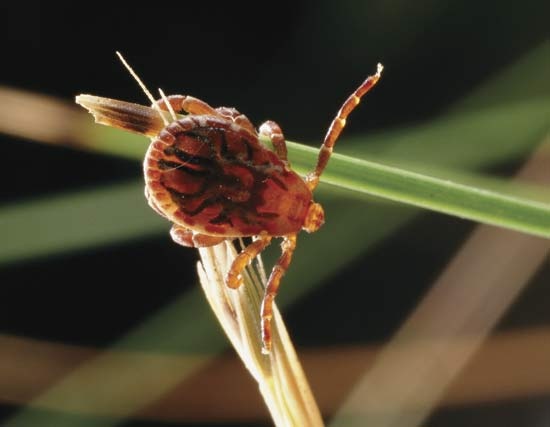tick
arachnid suborder
 any of about 825 species of invertebrates (invertebrate) in the order Parasitiformes (subclass Acari (acarid)). Ticks are important parasites (parasitism) of large wild and domestic animals and are also significant as carriers of serious diseases. Although no species is primarily a human parasite, some occasionally attack humans.
any of about 825 species of invertebrates (invertebrate) in the order Parasitiformes (subclass Acari (acarid)). Ticks are important parasites (parasitism) of large wild and domestic animals and are also significant as carriers of serious diseases. Although no species is primarily a human parasite, some occasionally attack humans.Hard ticks, such as the American dog tick (Dermacentor variabilis), attach to their hosts and feed continuously on blood for several days during each life stage. When an adult female has obtained a blood meal, she mates, drops from the host, and finds a suitable site where she lays her eggs in a mass and dies. Six-legged larvae hatch from the eggs, move up on blades of grass, and wait for a suitable host (usually a mammal) to pass by. The odour of butyric acid, emanated by all mammals, stimulates the larvae to drop onto and attach to a host. After filling themselves with the host's blood, the larvae detach and molt, becoming eight-legged nymphs. Nymphs also wait for, and board, a suitable host in the same way as larvae. After they have found a host and engorged themselves, they also fall off, and then they molt into adult males or females. Adults may wait for a host for as long as three years.
Most hard ticks live in fields and woods, but a few, such as the brown dog tick (Rhipicephalus sanguineus), are household pests. Soft ticks differ from hard ticks by feeding intermittently, laying several batches of eggs, passing through several nymphal stages, and carrying on their developmental cycles in the home or nest of the host rather than in fields.
Hard ticks damage the host by drawing large amounts of blood, by secreting neurotoxins (nerve poisons) that sometimes produce paralysis or death, and by transmitting diseases, including Lyme disease, Texas cattle fever, anaplasmosis, Rocky Mountain spotted fever, Q fever, tularemia, hemorrhagic fever, and a form of encephalitis. Soft ticks also are carriers of diseases.
Adults range in size up to 30 mm (slightly more than 1 inch), but most species are 15 mm or less. They may be distinguished from their close relatives, the mites (mite), by the presence of a sensory pit (Haller's organ) on the end segment of the first of four pairs of legs. Eyes may be present or absent.
This group has a worldwide distribution, and all species are assigned to three families: Argasidae, comprising the soft ticks, and Nuttalliellidae and Ixodidae, together comprising the hard ticks. The family Nuttalliellidae is represented by one rare African species.
- Sir Jagadis Chandra Bose
- Sir James, 1st Baronet Kay-Shuttleworth
- Sir James, 1st Baronet Outram
- Sir James, 1st Baronet Paget
- Sir James, 2nd Baronet Graham
- Sir James, 4th Baronet Hall
- Sir James Allen
- Sir James Balfour
- Sir James Black
- Sir James Chadwick
- Sir James Clark Ross
- Sir James Craig
- Sir James Dewar
- Sir James Douglas
- Sir James Dyer
- Sir James Fitzjames, 1st Baronet Stephen
- Sir James Fitzjames Stephen, 1st Baronet
- Sir James George Frazer
- Sir James Graham, 2nd Baronet
- Sir James Gray
- Sir James Hall, 4th Baronet
- Sir James Jeans
- Sir James Kay-Shuttleworth, 1st Baronet
- Sir James Lacaita
- Sir James Lancaster